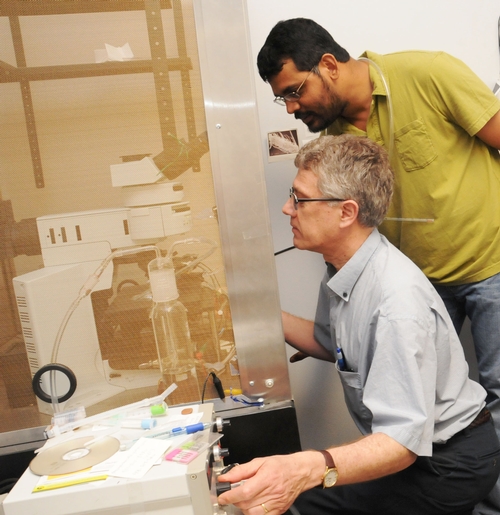Researchers in the Walter Leal lab, UC Davis Department of Entomology, are engaging in some exciting research.
They just discovered a "generic insect repellent detector" in the fruit fly (Drosophila melanogaster)--research published today (March 16) in PloS One (Public Library of Science).
What's exciting is that this research may lead to more effective and lower-cost products than DEET, the gold standard of insect repellents.
The five-member team found the sensory organs involved when fruit flies detect and avoid three key insect repellents: DEET, IR3535 and picaridin. They identified the olfactory receptor neuron (ORN) and characterized its receptor, DmOr42a.
The research team of Leal; primary author and chemical ecologist Zain Syed; chemical ecologist Julien Pelletier; and undergraduate students Eric Flounders and Rodrigo Chitolina, first found that the fruit fly avoids all three well-known repellents, DEET, IR3535 (a compound known as Avon Corporation’s “Skin-So-Soft Bug Guard”) and picaridin (derived from pepper) and then set out to find olfactory receptor neurons sensitive to those insect repellents. They scanned all olfactory sensilla in the antennae and the mouthpart structure, maxillary palps, using single unit electrophysiological recordings.
The receptor they found “fulfills the requirements for a simplified bioassay for early screening of test insect repellents,” they wrote in the scientific paper.
When you think that it takes about 10 years and $30 million to develop a new repellent--and only one test compound in 20,000 reaches the market--this could really speed up the process.
Zain Syed told us: "In this study, by using established behavioral assays to dissect the mechanism of repulsion in fruit flies, we demonstrated for the first time that Drosophila equally avoid other repellents--picaridin and IR3535. By challenging every type of olfactory sensilla on the antenna and maxillary palps, we identified neurons and then the odorant receptor that detect these repellents."
The UC Davis research, as Syed said, "adds a new dimension in research towards understanding the molecular, cellular and organismal response to repellents."
Chemical ecologist Coby Schal, the Blanton J. Whitmire Distinguished Professor of Entomology at North Carolina State University, praised the research as “an excellent example of translational research that can lead to a streamlined and less expensive path of discovery of new repellents.”
In earlier research, Syed and Leal identified a DEET-sensitive olfactory receptor neuron in the Southern House mosquito. “Going from the neuron to the receptor, however, is like looking for the proverbial needle in a haystack as the mosquito genome has some 181 olfactory receptor genes,” Schal said.
The Leal lab knows DEET. Back in August 2008, Leal and Syed drew international attention when they announced they'd discovered DEET’s mode of action or how it works. Scientists long surmised that DEET masks the smell of the host, or jams or corrupts the insect’s senses, interfering with its ability to locate a host. The Leal-Syed research showed that mosquitoes actually smell DEET and avoid it because they dislike the smell.
DEET, developed by scientists at the U.S. Department of Agriculture and patented by the U.S. Army in 1946, is the go-to insect repellent. Worldwide, more than 200 million use DEET to ward off vectorborne diseases.
Attached Images:

Chemical ecologists

Fruit Fly